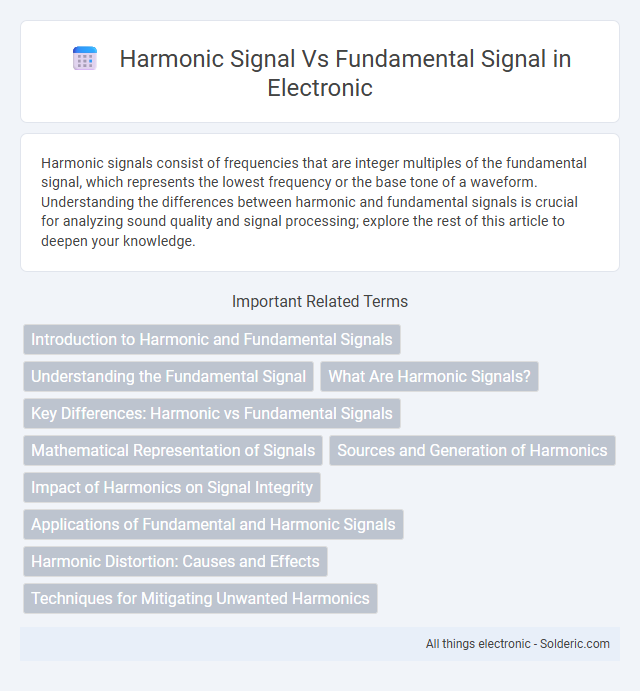Harmonic signals consist of frequencies that are integer multiples of the fundamental signal, which represents the lowest frequency or the base tone of a waveform. Understanding the differences between harmonic and fundamental signals is crucial for analyzing sound quality and signal processing; explore the rest of this article to deepen your knowledge.
Comparison Table
| Aspect | Harmonic Signal | Fundamental Signal |
|---|---|---|
| Definition | Signal component with frequency multiple of fundamental frequency | Signal component at the base or lowest frequency of a waveform |
| Frequency | Integer multiples (2x, 3x, 4x, etc.) of fundamental frequency | Original base frequency of the signal |
| Amplitude | Generally lower than fundamental, varies per harmonic order | Usually the highest amplitude in the signal |
| Role in Waveform | Shapes signal waveform, adding complexity and distortion | Defines the main tone or pitch of the signal |
| Mathematical Representation | n x fundamental frequency component (n = 2, 3, 4, ...) | Single frequency component f |
| Presence in Signals | Common in complex signals and non-linear systems | Present in virtually all periodic signals |
| Effect on Signal Quality | Can cause distortion or noise if unwanted | Essential for clear signal definition and intelligibility |
Introduction to Harmonic and Fundamental Signals
Fundamental signals represent the primary frequency components in a waveform, forming the basis of sound or vibration analysis. Harmonic signals are integer multiples of the fundamental frequency, contributing to the timbre and complexity of the overall signal. Understanding the relationship between fundamental and harmonic signals is essential in fields like acoustics, signal processing, and electrical engineering for accurate waveform synthesis and analysis.
Understanding the Fundamental Signal
The fundamental signal represents the lowest frequency component in a periodic waveform and serves as the basis for all harmonic signals. Harmonic signals are integer multiples of this fundamental frequency, contributing to the overall shape and complexity of the waveform. Understanding the fundamental signal allows you to analyze and manipulate the primary frequency that defines the wave's essential characteristics.
What Are Harmonic Signals?
Harmonic signals are sinusoidal waves whose frequencies are integer multiples of a fundamental signal's frequency, representing the complex waveform's components. These harmonics can distort power systems and affect signal quality in communication and audio systems by introducing unwanted frequencies. Analyzing harmonic signals is essential for improving system efficiency and ensuring accurate signal representation in engineering and physics applications.
Key Differences: Harmonic vs Fundamental Signals
Harmonic signals are integer multiples of the fundamental signal's frequency and contribute to waveform distortion and signal complexity in electrical and acoustic systems. The fundamental signal represents the lowest frequency component and defines the basic pitch or tone in a periodic waveform. Understanding the distinction between your fundamental and harmonic signals is essential for analyzing signal quality and improving system performance.
Mathematical Representation of Signals
The fundamental signal is mathematically represented as a simple sinusoidal function, typically expressed as \( x(t) = A \sin(2 \pi f t + \phi) \), where \( A \) is amplitude, \( f \) is frequency, and \( \phi \) is phase. Harmonic signals consist of multiples of the fundamental frequency, described as \( x_n(t) = A_n \sin(2 \pi n f t + \phi_n) \), with \( n \) being the harmonic order. Understanding the mathematical representation of these signals helps you analyze periodic waveforms in signal processing and electrical engineering.
Sources and Generation of Harmonics
Harmonic signals originate from nonlinear loads such as variable frequency drives, fluorescent lighting, and power electronic devices, causing distortion in electrical systems. Fundamental signals are generated by the primary power source, usually a sinusoidal voltage at the system's nominal frequency, typically 50 or 60 Hz. Harmonics arise when the ideal sinusoidal waveform of the fundamental signal is distorted by the switching actions and nonlinear characteristics of electronic equipment.
Impact of Harmonics on Signal Integrity
Harmonic signals distort the fundamental signal by introducing frequencies at integer multiples of the original frequency, causing signal integrity degradation through increased noise and interference. These harmonics can lead to waveform distortion, reduced signal-to-noise ratio, and timing errors in electronic systems, ultimately impacting the accuracy of data transmission and processing. To preserve your system's reliability, it is essential to minimize harmonic distortion using proper filtering and signal conditioning techniques.
Applications of Fundamental and Harmonic Signals
Fundamental signals serve as the primary frequency components in communication systems, enabling effective data transmission and signal synthesis in audio and radio technologies. Harmonic signals, which are integer multiples of the fundamental frequency, play crucial roles in power quality analysis, vibration monitoring, and harmonic distortion assessment in electrical engineering. Both types of signals are essential in signal processing algorithms for speech recognition, musical tone generation, and fault detection in mechanical and electrical systems.
Harmonic Distortion: Causes and Effects
Harmonic distortion occurs when non-linear loads or devices generate signals at multiples of the fundamental frequency, leading to harmonic signals that interfere with the original fundamental signal. These harmonics cause waveform distortion, resulting in increased power losses, overheating of equipment, and reduced efficiency in electrical systems. Mitigating harmonic distortion is crucial for maintaining signal integrity, ensuring accurate measurements, and protecting sensitive electronic components.
Techniques for Mitigating Unwanted Harmonics
Passive filters and active power filters are commonly employed to mitigate unwanted harmonic signals by targeting specific harmonic frequencies and reducing distortion in power systems. Techniques such as harmonic traps and tuned filters enhance the suppression of harmonics without affecting the fundamental frequency, improving power quality. Advanced methods include real-time harmonic compensation using power electronics, which dynamically adjust to fluctuating harmonic levels, ensuring stable and efficient electrical system operation.
harmonic signal vs fundamental signal Infographic

 solderic.com
solderic.com